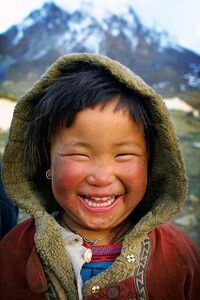Koshi: Difference between revisions
Jump to navigation
Jump to search
Lyooonheimer (talk | contribs) No edit summary |
Lyooonheimer (talk | contribs) No edit summary |
||
| Line 27: | Line 27: | ||
| ref33 = | | ref33 = | ||
| languages = [https://en.wikipedia.org/wiki/Tibetan_script Carelitan] | | languages = [https://en.wikipedia.org/wiki/Tibetan_script Carelitan] - [[Mahanan]] (Osh-Mandi Tongue) - [[Josharala]] | ||
| religions = 64.2% [[Gaism]] | | religions = 64.2% [[Gaism]] - 46.8% [[Plateuan Traditional Religions]] | ||
| related_groups = [[Gaimreti]] | | related_groups = [[Gaimreti]] - [[Tamang]] | ||
| footnotes = | | footnotes = | ||
}} | }} | ||
Revision as of 19:56, 5 April 2022
ཁོའོ་ཧྲི། | |
|---|---|
 A young Koshi child. | |
| Regions with significant populations | |
| 119,200(estimate) | |
| Languages | |
| Carelitan - Mahanan (Osh-Mandi Tongue) - Josharala | |
| Religion | |
| 64.2% Gaism - 46.8% Plateuan Traditional Religions | |
| Related ethnic groups | |
| Gaimreti - Tamang | |
The Koshi people (Mahanan:कोशी) are one of the larger ethnic groups in Mahana, with a 2021 population estimate of around 119,200 million people. They are closely related to the Gaimreti peoples, both originating on the Careleon Plateu. A majority of the population still reside in the Careleon Plateu, often still living the hunter-gatherer lifestyles.